 DANISH DELIGHTS
DANISH DELIGHTS
30 April 1999
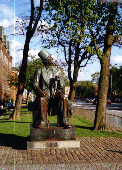 Statue
of Hans Christian Andersen
Statue
of Hans Christian Andersen
On our way to Stansted Airport, we heard about the bombing at Soho on the radio. Gosh, when will the next bombing occur ? Two other bombings had occurred before, one week from one another, and each had occurred in a different area. The first in an Afro-Caribbean area, the second in the Bangladeshi area, and now in a gay bar in Soho. London is becoming dangerous during the weekends.
The plane set off as scheduled. We had our first taste of Danish cuisine on the SAS flight - some pieces of cold salmon with a strange sauce. Not very inspiring. The landing was even less settling - the plane vibrated unusually and Kenny thought it was not far from the water level as it was landing. There were moments during which I thought my odyssey would end once and for all in the icy cold waters of the Baltic. As in other similar situations during my many travels, I gently touched the talisman of Guan Yin (a Chinese-Buddhist deity) which I wore around my neck. My confidence returned when the plane finally landed safely.
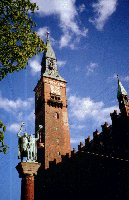 The brand new Copenhagen Airport was a saving grace. Clearing the
customs was a breeze, not to mention the shiny cleanliness of the place.
Everything appeared to be in order. This was Scandinavia after all.
Clean and efficient. Like Singapore.
The brand new Copenhagen Airport was a saving grace. Clearing the
customs was a breeze, not to mention the shiny cleanliness of the place.
Everything appeared to be in order. This was Scandinavia after all.
Clean and efficient. Like Singapore.
We hopped onto a taxi which brought us to Cab Inn Scandinavia.
It cost DKK 520 for a double room - one of the best deals in town.
It was around midnight by then and we slept early to be ready for our short
Danish adventure.
1 May 1999
Woke up to a bright sunny Copenhagen. A quick breakfast in the hotel and we were off to explore the city centre. The streets were clean and there were few cars. The place was unusually quiet and we appeared to be the only jokers on the streets. The Danes were probably still on their beds after a night of heavy drinking on Friday. The main boulevards were also wide compared to London. In that sense, it was a little Parisian, but not quite - as there were few grand buildings and certainly no phallic obelisks stolen from Egypt. Certainly the Danish Empire was too far north and ended well before the age of globalised imperialism began. The Danes once had a colony far from its shores – the Danish West Indies, now known as the US Virgin Islands. They realised that it wasn't economic to maintain these godforsaken islands and sold them to the United States in 1917.
The Rådhus (City Hall) was monumental although it would be an "average grand building" in Florence or Paris. The golden statue of a bishop on the Rådhus was quite impressive. Across the road to the left of the Rådhus stood the Palace Hotel with its impressive art deco painting on its tower. The statue of Hans Christian Andersen, whose fairy tales are the world’s second most translated works (The Bible won the top honour) stood beside the Rådhus. Huh, this was the man whom I grew up with ! It's amazing how his fairy tales shaped the imagination of millions of children worldwide. But of course this did not necessarily taught them to do good – I am sure the likes of Hitler and Milosevic read his works as well in their tender age. Across the street was Tivoli, the world-famous amusement park. We would be there later.
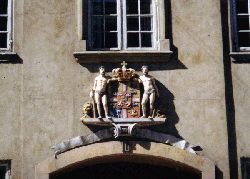 After the National Museum, we explored Slotsholmen, an island separated
from Copenhagen’s city centre by a narrow canal. This is the political
centre of Denmark. Occupying most of the island was the tall monstrous-sized
Christiansborg Palace, also seat of the government. In the middle
compound of the palace was the statue of King Christian IV, and surrounding
the compound were trees trimmed in almost repulsive, unnatural shapes.
The palace was tall but wasn’t exactly inspiring architecturally.
It kind of resembled the Moscow State University building. The sole
redeeming feature was the Dannebrog (meaning “flag of the Danes” or the
“red flag”) flapping in front of the palace’s main building. The
Danish national flag was first adopted in 1219 when the Danish army supposedly
defeated the pagan Estonians near Tallinn after a providential sign in
the form of a cross appeared in the sky. The flag flapped in the
bright blue skies, in positive contrast to the reddish misery of the Palace
(one sometimes sees the swallow-tailed flag, which is the royal standard).
On the island was also the Folketing, Denmark’s Parliament the house that
runs the model Scandinavian democracy that is the Denmark of today.
After the National Museum, we explored Slotsholmen, an island separated
from Copenhagen’s city centre by a narrow canal. This is the political
centre of Denmark. Occupying most of the island was the tall monstrous-sized
Christiansborg Palace, also seat of the government. In the middle
compound of the palace was the statue of King Christian IV, and surrounding
the compound were trees trimmed in almost repulsive, unnatural shapes.
The palace was tall but wasn’t exactly inspiring architecturally.
It kind of resembled the Moscow State University building. The sole
redeeming feature was the Dannebrog (meaning “flag of the Danes” or the
“red flag”) flapping in front of the palace’s main building. The
Danish national flag was first adopted in 1219 when the Danish army supposedly
defeated the pagan Estonians near Tallinn after a providential sign in
the form of a cross appeared in the sky. The flag flapped in the
bright blue skies, in positive contrast to the reddish misery of the Palace
(one sometimes sees the swallow-tailed flag, which is the royal standard).
On the island was also the Folketing, Denmark’s Parliament the house that
runs the model Scandinavian democracy that is the Denmark of today.
Northwest of Slotsholmen was a square known as Hojbro Plads, crowned by the statue of Bishop Absalon in armour and riding a horse. It reminded me of the days bishops were warriors and led armies onto battlefields. Indeed, Absalon, Bishop of the royal city of Roskilde (1158-91), Archbishop of Lund (1177-1202) and founder of Copenhagen, was a well known Viking chief and even as a clergyman, ravaged the coasts of Pomerania (today’s northeast Germany and north Poland).
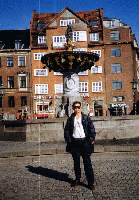 On the Hojbro Plads were a number of cafes and lots of locals out to enjoy
the bright sunny day. This is also the Strøget area, with
one of Europe’s first pedestrian streets, lots of shops and crowded roadside
cafes. We looked for a café recommended by a friend.
It was supposed to serve traditional Danish meals. Found it but we
decided that the buffet spread with icy, raw shrimps and herrings and assortment
of vegetables was too coldly unfamiliar for our Asian tastes.
On the Hojbro Plads were a number of cafes and lots of locals out to enjoy
the bright sunny day. This is also the Strøget area, with
one of Europe’s first pedestrian streets, lots of shops and crowded roadside
cafes. We looked for a café recommended by a friend.
It was supposed to serve traditional Danish meals. Found it but we
decided that the buffet spread with icy, raw shrimps and herrings and assortment
of vegetables was too coldly unfamiliar for our Asian tastes.
We then set off for Nyhavn in the northeast of the city where Lonely Planet recommended a restaurant which serves herring buffet. Nyhavn, or New Harbour in Danish, was built 300 years ago and soon become the haunt of sailors, whores and bohemians (not the Czechs, but the hippy sort of older days). Even Hans Christian Andersen once lived there. I wonder if the colourful life of this place had inspired him in his writings. The age of the sailing boat was long gone, and like other former quays round the world, this one has been converted into a semi-tourist trap plus yuppie watering hole.
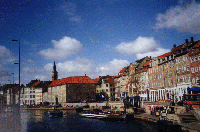 We
found the LP-recommended restaurant, and had lunch there, although none
of us could consume much herrings with cold sauce. After lunch, we
took a cruise from the Nyhavn Harbour. Passed by Little Mermaid as
well as many old warehouses now in the process of being converted into
shopping centres, offices and anything kitsch - no different from similar
efforts transforming old port districts elsewhere in the world.
Nothing else to be seen. The most conspicuous landmarks were building
cranes and pipes. It must be the most uninteresting cruise I had
ever taken. I even dozed off on the boat.
We
found the LP-recommended restaurant, and had lunch there, although none
of us could consume much herrings with cold sauce. After lunch, we
took a cruise from the Nyhavn Harbour. Passed by Little Mermaid as
well as many old warehouses now in the process of being converted into
shopping centres, offices and anything kitsch - no different from similar
efforts transforming old port districts elsewhere in the world.
Nothing else to be seen. The most conspicuous landmarks were building
cranes and pipes. It must be the most uninteresting cruise I had
ever taken. I even dozed off on the boat.
After the cruise, we explored the northeast of the city, passing Amalienborg Palace, home to the Danish Royal Family since 1794. The Danish royal house is one of the world’s oldest. It survived more than a thousand years, from the founding of the Danish monarchy by King Harald, through various wars and disasters, to today’s Queen Margrethe II, who came to the throne in 1972. The Danish royal family is boring, as it is simple and non-glamorous, and avoids excessively publicity to the popular press. Its members also behave themselves. As a result, it stayed clear of the mess the British monarchy got itself into. Hence, the Danish royals are very popular with the Danish people. It is said that the Danes would elect their Queen president if the country ever becomes a republic. And yes, the monarchy did become more interesting in recent years, when Prince Joachim, second son of the Queen, married a Hong Kong Chinese he met while working as a trainee in Mærsk’s (Denmark’s largest and one of the world’s largest shipping companies) Hong Kong office. In contrast, Prince Charles of the Windsors could not even married the one he loved because she was Catholic, despite the fact that they were all members of that stiff upper lipped class, thus leading to the tragic drama that all of us are only too familiar with.
Gigantic pipes, power stations and chimneys formed a “wonderful” and
“picturesque” backdrop to the statue. I wonder if this was deliberate.
Perhaps, the Danish Tourist Board drew inspiration from the recently buried
“socialist people’s democracies” in eastern and central Europe, whose propaganda
units used to display images of similar architectural delights as achievements
of the socialist state.
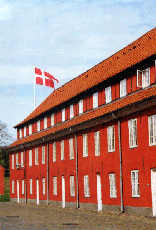 |
We returned to the city centre, explored the Stroget, and then visited
Tivoli, the famous amusement park. Built more than a hundred years
ago by Hans Christian Andersen’s contemporary, a maverick businessman named
Georg Carstensen, it has become one of Copenhagen’s main attractions.
It boosts numerous rides, more than 100,000 lamps, and a strange pseudo-oriental
architectural style that appears so kitsch and embarrassingly stereotypical.
Exotic to the locals, I suppose, but amazingly bizarre to someone who came
from that part of the world. Rides there recalled the tales from
Andersen’s works. The life of its founder, Carstensen, was as tragic
as some of these tales. He lived abroad for some years, returned
to Denmark in 1855 (12 years after the opening of Tivoli), a bankrupt man,
found himself no longer recognised and had to enter the park through the
turnstiles. We wondered round the park. It was crowded with
families enjoying the good day out. For those who had been to Disneyland,
Tivoli was a disappointment. Its rides were provincial – its equivalent
of Disney’s “It’s a Small World” was short and repetitive, and the statues
don’t move at all - and food overpriced. We had dinner at Hard Rock
Café instead.
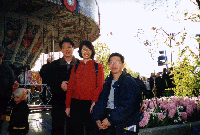 |
Click here to send your comments to Tan Wee Cheng, Singapore